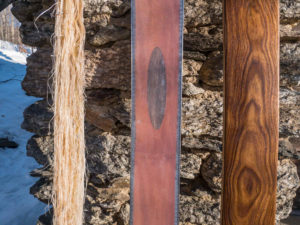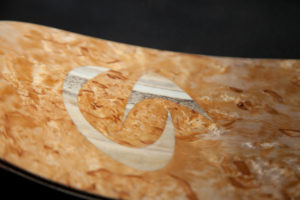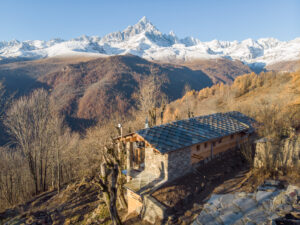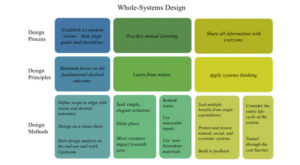Systemic Design (SD) is the science-based creative dealing with complexity for advancing pathways towards regenerative systems. SD is research by design and design informed by science. It emerges at the overlays of system boundaries, across nested scales, where – as in nature – biodiversity is the highest, and thus the leverage potential for sustainability solutions. SD has the capacity to (re)create circular systems that restore, renew or revitalize their own sources of existence, of energy and materials – learning from natural ecosystems to create resilient societies in integrity with nature.
Visit the ETH Zurich Systemic Design Labs
Regenerative Design is systemic and describes the integration between systems thinking and design theory and practice, with sustainability science, learning from nature. Building upon their very different traditions, this inter- and often transdisciplinary combination enables people to take more effective action toward improving the wicked, emergent-complex sustainability challenges our societies are facing. If we want to solve a complex (sustainability) problem, we need to look at a system from an integrative, whole life cycle perspective, at several nested scales, employing an organic design research process.

A system can be a product, a building, a community, a larger governance system, or even the entire global environment. Looking at the whole system instead of focusing on a single link, we understand that everything is connected.
My initial academic training in forest sciences and wood engineering empowered me to abstract nature’s design principles to mimic its genius design solutions. Forest ecosystems are hugely complex and their understanding and sustainable management requires a systemic approach.
As a Systemic Designer, I merge sustainability science, design(erly) thinking and doing, handcrafting and entrepreneurship for contributing to the eco-social transformation through regenerative solutions.

I combine skills of systems thinking, transdisciplinary research, regenerative design and hands-on engineering and building to systemically address complex design challenges with methods that go beyond current design and engineering approaches (e.g. Jones 2014).
While I am teaching Regenerative Design for resilient systems at ETH Zurich, AHO Oslo and Politecnico Torino, and publishing on theoretical constraints of SD, my work involves applied designing of products, services and communication in the fields of outdoor and lifestyle (sporting) goods (Grown outdoor creativity lab), resilient governance systems in (mountain) communities (ArcAlpNet), responsible tourism (Sustainable Mountain Tourism Alliance), wood/forestry/supply chains and the design of circular economies, and architecture (Swall Institute, MonViso Institute).

One current architectural, systemic design project is the transformation of an abandoned group of stone houses in the Italian Piedmont mountains to a hub for research, education and entrepreneurship in sustainability transformations and social-ecological design – the MonViso Institute (MVI). The MVI serves as a field experiment for whole systems design of buildings and their integration into their natural and socio-cultural surroundings, as a non-profit center for research, education and entrepreneurship in sustainability innovations, as a mountain observatory, and as a meeting hub for living a new “Alpine Urbanism”.

Some background on regenerative/ systemic/ whole systems design
Todays „wicked“ sustainability problems require new foci and new tools for designing the eco-social transformation towards a more sustainable society (e.g. Brown and Wyatt 2010). Design thinking is becoming increasingly important for solving sustainability problems (e.g. Fischer 2015).
The complexity of interrelated social and ecological systems and changes demands design solutions from a whole systems design perspective, which is at the core of my interests and skills in sustainability science and engineering design. Everything is connected, and any decision or any design has consequences. Designing the transformation towards a sustainable society is becoming increasingly challenging, while systemic design or “whole systems design”, as discussed in Blozzard and Klotz (2012), is a rather young, interdisciplinary field (Figure 1).
My experience in engineering design research through my work with the eco innovation and sustainable design lab Grown feeds my interest in design research. I have signed responsible for product and process design, and communication design, combining engineering design research, design of products, business design, and communication design. I led and published the first environmental and social life cycle analysis (LCA) of skis in the leading Journal of Industrial Ecology, on sustainable technical product design (Luthe et al. 2013). We use this LCA for the social-ecological design of skis and propose a systems approach including virtual development techniques for sustainable technical product design.
Putting a sustainability vision first. Applying a systemic design process fueled by creative open innovation and participatory brainstorming methods, using backcasting and abductive logic and a cross-validation of solutions – this is one approach to sustainable resource management.
In my current research I extend such whole system design work and transfer it to other industry sectors. This research looks more at design thinking – for the design of products, services, and communication – and designerly thinking as an academic discourse (Brown and Wyatt 2010), in its relevance for sustainable resource management. One specific aspect of transition research and resilience assessment in a resource management context is the development of circular economy systems and regenerative design.
Further info on systemic design by the Systemic Design Research Network
References
Blizzard, J. L. and L. E. Klotz. 2012. A framework for sustainable whole systems design. Design Studies 33(5).
Brown, T. and J. Wyatt. 2010. Design thinking for social innovation. Stanford Social Innovation Review. Stanford University.
Fischer, M. 2015. Design it! Solving Sustainability problems by applying design thinking. GAIA 24/3:174-178.
Jones, P. 2014. Design research methods for systemic design: Perspectives from design education and practice. Proceedings of ISSS 2014, July 28 – Aug1, 2014, Washington, D.C.
Luthe, T. 2020. Designing for Circularity in a Real-world context: Understanding Cooperative Benefits to Foster Individual Action for a Regenerative Economy. Newsletter “Network City and Landscape“, ETH Zurich.
Swat, J., Luthe, T. and B. Sevaldson. 2019. When Is Systemic Design Regenerative? Values, direction and currencies in systemic design methodology. In: Proceedings of Relating Systems Thinking and Design (RSD8) 2019 Symposium. IIT Institute of Design, Chicago, October 13-15, 2019. Systemic Design Association. ISSN 2371-8404. Link to a movie summarizing the fishbowl method.
Luthe, T. 2020. Ski Systems Design – Building Fjell skis as part of a broader mountain tourism system. In: Systems Oriented Design. The designerly way to work with systems. systemsorienteddesign.net
Luthe, T., Lumpe, T., Schwarz, J., Schuetz, M. and K. Shea. 2017. Teaching Systemic Design For Sustainability In Engineering By Building Eco-Skis. ETH Zurich. Proceedings of the 21st Conference on Engineering Design ICED17. UBC, Vancouver.
Luthe, T., Kaegi, T. and J. Reger. 2013. A Systems Approach to Sustainable Technical Product Design. Combining life cycle assessment and virtual development in the case of skis. Journal of Industrial Ecology 17(4), 605-617. DOI: 10.1111/jiec.12000
Wahl, C. 2016. Designing Regenerative Cultures. Triarchy Press, England. ISBN 978-1-909470-77-4.

